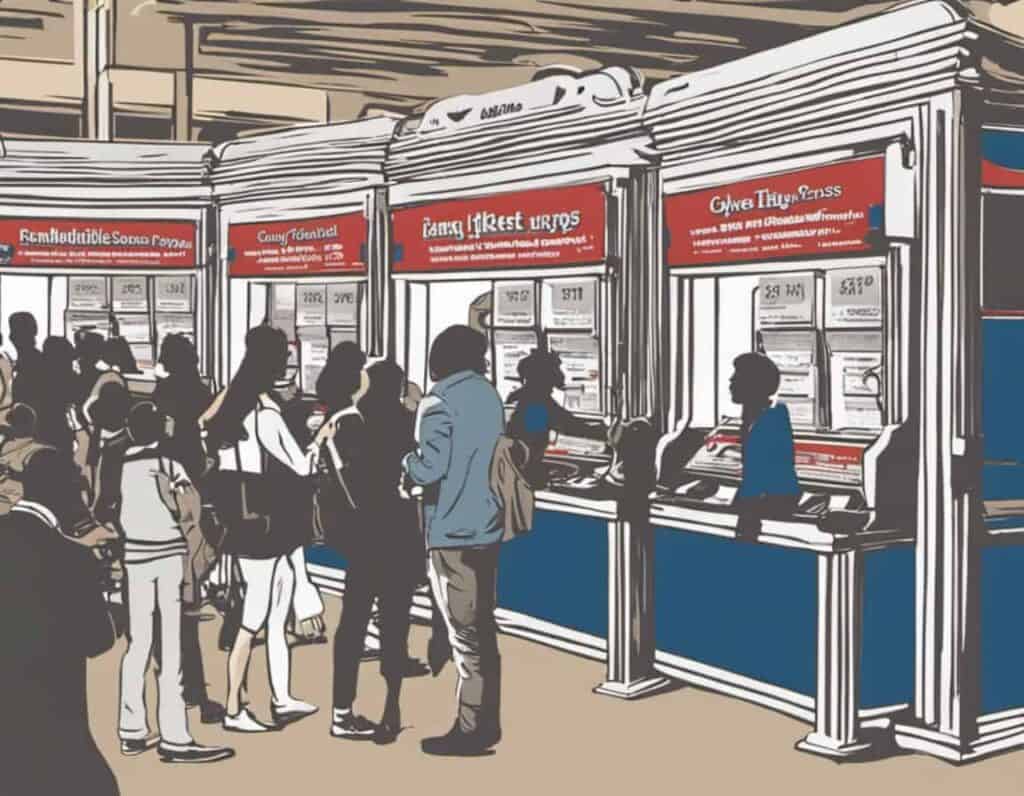Do you remember the last time you were handed a ticket to a fundraising event? That tiny piece of paper or digital code is more than just a gateway; it’s a bond between the donor and the cause.
For fundraising event organization leaders and teams, event ticketing isn’t just about allowing entry; it’s about creating a memorable and seamless experience that optimizes both revenue and donor satisfaction.
But how do you ensure this happens? Let’s delve into some actionable tips that will transform your ticketing approach.
1. Setting the Right Ticket Price
In the realm of fundraising, establishing the appropriate ticket price is analogous to calibrating a delicate instrument. It’s not about plucking numbers out of thin air but about precision and strategy.
The price of a fundraising ticket carries a dual responsibility—it must reflect both the tangible and intangible values offered to attendees while ensuring the sustainability and profitability of the event.
Let us now transition to the essential strategies and considerations that come into play when setting that pivotal ticket price.
A. Analyzing Historical Data
A comprehensive study of previous events can offer significant insights into the dynamics of ticket pricing. Historical data reveals patterns and trends that can guide the pricing decisions for upcoming events.
- Review past ticket sales velocity and trends.
- Assess the correlation between price points and attendee satisfaction.
- Investigate if early-bird pricing had a measurable impact.
- Understand the financial outcomes of past pricing strategies.
- Gauge the impact of tiered ticket pricing, if implemented.
- Analyze attendee feedback specifically related to perceived value vs. price.
- Take note of any external factors that might have influenced past sales, such as economic conditions.
B. Perceived Value to Attendees
The price should resonate with what the donors perceive as value, both in terms of the cause and the event experience itself.
- Conduct surveys to understand attendees’ value perception.
- Offer tiered ticketing, providing different benefits at varying price points.
- Highlight exclusive offerings or experiences associated with the event.
- Showcase testimonials from previous attendees emphasizing value.
- Consider bundling additional perks or gifts with tickets.
- Emphasize the philanthropic impact of their ticket purchase.
- Keep attendees informed about what their contributions will achieve.
C. Competitive Analysis
Recognizing how peer organizations price their event tickets can provide a benchmark and identify any industry standards.
- Study ticket prices of similar events within the same geographical area.
- Understand the value propositions offered by competitors.
- Analyze any unique pricing models or incentives used by peers.
- Keep track of any promotional or discounted pricing strategies.
- Compare the scale, magnitude, and offerings of events.
- Evaluate the brand equity and reputation of competing events.
- Use gathered data to position your event effectively in the market.
D. Operational Costs and Break-Even Analysis
A realistic assessment of all costs associated with the event is pivotal. It ensures that the ticket price covers expenses while also raising funds for the cause.
- Detail all fixed and variable costs associated with the event.
- Calculate the break-even ticket price.
- Factor in contingencies and unforeseen expenses.
- Understand the desired profit margin or fundraising event goal.
- Take into account non-ticket revenue streams (e.g., sponsorships, merchandise).
- Determine if bulk or group pricing could be advantageous.
- Regularly review and update the budget as the event approaches.
E. Flexibility and Adaptability
The initial pricing strategy may require adjustments based on changing circumstances, feedback, or ticket sales velocity.
- Monitor ticket sales closely, especially during the initial phase.
- Be prepared to introduce mid-campaign promotions if needed.
- Solicit feedback and be open to recalibrating prices.
- Use dynamic pricing models, adjusting based on demand.
- Offer special discounts to loyal patrons or major donors.
- Consider last-minute pricing strategies to boost attendance.
- Always communicate transparently with potential attendees about any pricing changes.
Strategically determining the price of a fundraising ticket is both an art of perception and a science of data-driven decision-making, ensuring the event’s success and fostering a sense of value among attendees.
2. Diversifying Ticket Types
In the intricate dance of fundraising, offering a singular ticket type is like playing just one note in an orchestra. It lacks depth, variation, and, most importantly, the ability to resonate with a diverse audience.
Crafting a diversified ticket lineup not only amplifies the appeal of the event but significantly enhances the donor’s experience by granting them agency in their participation.
Now, let’s pivot our focus to the strategies and techniques essential for this diversification.
A. Identifying Donor Segments
The first step in diversification is a clear understanding of your donor base. Recognizing their preferences, financial capacity, and motivation for attending the event is pivotal.
- Conduct donor surveys to gauge preferences and willingness to pay.
- Categorize donors based on past event attendance and contribution levels.
- Use analytics to discern patterns in donor behavior.
- Assess the frequency of their participation in past events.
- Segment donors based on their engagement with your organization’s communication channels.
B. Tiered Ticket Offerings
By creating multiple ticket tiers, you provide donors with options that reflect their engagement level, from casual supporters to ardent benefactors.
- Design an early bird ticket to incentivize early commitments.
- Create VIP or premium packages with exclusive benefits.
- Offer group or family tickets for bulk purchases.
- Consider discounted student or senior citizen tickets.
- Introduce a “pay-what-you-can” ticket for inclusivity.
C. Bundling and Add-ons
Bundling involves pairing the event ticket with additional perks or experiences, enhancing its perceived value.
- Pair tickets with merchandise, like event T-shirts or mugs.
- Offer special workshops or sessions as add-ons.
- Include meal or refreshment vouchers with certain ticket tiers.
- Provide exclusive meet-and-greet opportunities for higher ticket tiers.
- Offer opportunities for attendees to donate extra for a specific cause or project.
D. Dynamic Pricing Model
A flexible pricing strategy can be employed, where ticket prices adjust based on factors like time, demand, or available inventory.
- Start with a higher ticket price and reduce closer to the event date.
- Adjust prices based on ticket sales velocity.
- Offer flash sales or limited-time discounts.
- Utilize event management software that supports dynamic pricing.
- Offer exclusive discounts to members or returning attendees.
E. Feedback and Iteration
Continuous feedback from attendees and patrons helps refine and improve the diversification strategy for future events.
- Use post-event surveys to gather feedback on ticket types and pricing.
- Analyze ticket sales data to discern popular and less-popular ticket tiers.
- Adjust and introduce new ticket types based on trends and preferences.
- Engage with donors directly to understand their needs better.
- Host focus groups or community forums to get in-depth insights.
Diversifying ticket types is a nuanced approach to inclusivity, ensuring that every donor finds a place and feels valued in your fundraising narrative.
3. Effective Promotion Strategies
Crafting an impeccable fundraising event is like creating a masterpiece, but even the most captivating paintings need a spotlight. The challenge then pivots from event creation to event promotion, ensuring that your masterpiece shines and resonates with its intended audience.
It’s this bridge between meticulous planning and widespread awareness where promotion strategies become the linchpin.
As we proceed, we’ll dissect the vital facets of effective promotional maneuvers and their actionable implications.
A. Harnessing Social Media Dynamics
- Regularly update event countdowns or behind-the-scenes glimpses.
- Collaborate with influencers or local celebrities for event shoutouts.
- Use targeted ads to reach specific demographics or interests.
- Engage in real-time with followers through Q&A sessions or polls.
- Encourage followers to share the event for special discounts or privileges.
B. Personalized Email Campaigns
- Segment your email list based on donor history, interests, or demographics.
- Use engaging subject lines to increase open rates.
- Incorporate multimedia, like videos or infographics, for a dynamic email experience.
- Provide clear call-to-actions, leading directly to ticket purchase.
- Monitor analytics, like click-through rates, to refine subsequent campaigns.
C. Building Strategic Partnerships
- Collaborations, be it with local businesses, media houses, or other nonprofits, amplify your event’s credibility and reach.
- Identify and approach partners whose values align with your event.
- Co-host promotional events or webinars leading up to the main event.
- Offer mutual benefits, such as logo placements or shoutouts.
- Utilize partners’ platforms for extended promotion, like guest blog posts.
- Ensure consistent messaging across all partner platforms.
D. Leveraging Traditional Media Outlets
- Despite the digital surge, traditional media—like newspapers, radio, or television—retain significant influence in certain demographics.
- Draft compelling press releases highlighting the event’s unique selling points.
- Secure radio or TV spots during prime hours for maximum visibility.
- Collaborate with local journalists for event feature articles.
- Offer exclusive media passes for coverage on the day of the event.
- Use localized marketing in community newspapers or magazines.
E. Optimizing Search Engine Visibility
- SEO and online ads can significantly boost event visibility for users actively seeking similar experiences or opportunities.
- Optimize your event website or landing page with relevant keywords.
- Engage in pay-per-click advertising targeting event-related queries.
- Ensure mobile optimization for users searching on-the-go.
- Create quality backlinks through guest blogging or partner sites.
- Utilize event schema markup to enhance search result listings.
While the essence of your fundraising event is paramount, its promotion is the heartbeat that ensures its lifeblood reaches far and wide.
By adopting a multifaceted promotional strategy, the masterpiece you’ve crafted can truly achieve the recognition and response it richly deserves.

4. Crafting a Seamless Purchase Experience
In the fundraising event sphere, the ticketing experience isn’t merely a transactional avenue but the initial handshake between your organization and the donor. It’s the first impression, and as the adage goes, those matter immensely.
A disjointed or cumbersome ticketing process can potentially alienate potential donors, eroding trust before it’s even established. Recognizing its criticality is paramount.
A. Intuitive User Interface
The ticketing platform should be more than functional; it should guide the user effortlessly from beginning to end. It’s the virtual ambassador of your event, setting the tone for what’s to come.
- Ensure a clean design, free from clutter or distractions.
- Opt for a logical flow, where each step leads naturally to the next.
- Highlight critical information like event details, dates, and prices clearly.
- Regularly test and refine the interface based on user feedback.
- Incorporate responsive design to ensure seamless navigation on any device.
- Minimize the number of clicks needed to finalize a purchase.
- Offer a quick recap before finalizing the transaction, allowing users to review and modify their selections.
B. Versatile Payment Gateways
Today’s donors come with diverse preferences, especially when it comes to financial transactions. Catering to this diversity is no longer a luxury but a necessity.
- Integrate multiple payment options like credit cards, digital wallets, and bank transfers.
- Ensure all payment gateways are secure, building trust with your donors.
- Offer an option for recurring donations or pledges for future events.
- Clearly indicate any additional fees or charges upfront.
- Provide instant confirmation messages or emails upon successful transactions.
- Keep the payment process short, avoiding unnecessary steps or information requests.
- Stay updated on emerging payment methods and integrate them when feasible.
C. Prompt Support and Feedback Channels
Even the most refined systems can face hitches. When they arise, your response time and efficiency can make or break the donor’s experience.
- Offer a live chat or helpline for immediate assistance during the ticketing process.
- Ensure that FAQs are easily accessible, addressing common queries.
- Encourage post-purchase feedback to continuously refine the experience.
- Have a contingency plan for high-traffic scenarios, ensuring your site doesn’t crash during peak times.
- Regularly update donors about event changes, using the ticketing platform as a communication channel.
- Monitor backend analytics to identify and rectify common issues faced by users.
- Collaborate with tech teams to ensure periodic maintenance and updates, avoiding potential glitches.
A ticket purchase, while seemingly simple, is the initial pledge of support from a donor. It is incumbent upon organizations to ensure that this initial commitment is nurtured with an effortless experience, laying the foundation for lasting engagement.
5. Post-Purchase Engagement
In the realm of fundraising events, securing a ticket purchase signifies the start of a donor’s journey, not its conclusion. It’s the inaugural step, a pledge of support, that leads to potential long-term collaboration.
Hence, the period following this commitment is as crucial as the lead-up. Cultivating post-purchase relations isn’t about transactions anymore; it’s about building connections and fostering loyalty.
A. Continuous Communication
The silence after a purchase can be disconcerting for donors. It’s vital to keep the channels of communication flowing, ensuring they’re in the loop about what their contribution is achieving.
- Dispatch a heartfelt thank-you message immediately post-purchase.
- Offer periodic updates on event preparations or the progress of the cause.
- Provide sneak peeks behind the scenes to be more inclusive.
- Inform donors of event updates.
- Use varied communication mediums – emails, texts, or even personalized videos.
- Encourage feedback to understand their expectations and refine your engagement strategies.
B. Exclusive Access and Offers
Rewarding donors for their support can deepen the bond, making them feel valued beyond their financial contribution.
- Offer early-bird access or discounts to upcoming events.
- Share exclusive digital content like webinars or interviews with keynote speakers.
- Provide special badges or recognition for consistent supporters.
- Introduce loyalty programs or tier-based benefits for repeat donors.
- Organize donor-only networking or interactive sessions.
- Curate special merchandise or memorabilia as tokens of appreciation.
C. Feedback Loops and Surveys
Engaging is a two-way street. Taking the time to understand your donor’s perspective can inform and enhance your future strategies.
- Conduct post-event surveys to gauge satisfaction and areas of improvement.
- Open channels for direct feedback, ensuring donors feel heard.
- Use this feedback to tweak and adapt your engagement strategies.
- Host focus groups or interactive sessions to co-create future event themes or features.
- Regularly share how feedback is shaping organizational changes.
- Recognize and appreciate donors who actively provide constructive feedback.
D. Reinforcing the Impact of Their Contribution
Reminding donors of the tangible difference their support makes can fortify their connection to the cause.
- Share success stories or case studies resulting from their contributions.
- Regularly update them on the progress of the project or cause they supported.
- Use visual aids like infographics or videos to depict impact.
- Organize field visits or virtual tours for donors to see their contributions in action.
- Dedicate a section in newsletters or annual reports to highlight donor contributions.
- Send personalized impact reports, linking their donation to specific outcomes.
The purchase of a ticket isn’t a finale, but rather an overture. For organizations, it’s the commencement of a symphony of engagement, an opportunity to craft a harmonious and enduring bond with their supporters.
6. Offering Unique Value Propositions
In the intricate dance of fundraising, a compelling value proposition is your standout move, setting the rhythm and drawing the crowd. It’s the spark, the distinction, that separates your event from the myriad others.
What does your fundraising offer that others don’t? Identifying and highlighting this unique facet is pivotal, acting as your magnet to pull donors towards your cause.
But how does one hone in on this element and amplify it for maximum effect? Let’s navigate the avenues of creating and showcasing your distinctive value propositions.
A. Exclusive Content or Personalities
A sought-after speaker or a world-class performer can set your event miles apart from the rest. This type of exclusive content acts as a beacon, drawing potential donors in.
- Collaborate with influencers or celebrities aligned with your cause.
- Host workshops led by experts in the field.
- Organize panel discussions with thought leaders.
- Promote such exclusivities prominently in all marketing materials.
- Ensure such content aligns seamlessly with your event’s theme and audience.
B. Innovative Engagement Models
Engage donors not just as passive attendees but as active participants, making your event a memorable experience.
- Incorporate interactive sessions or Q&A segments.
- Use technology like AR or VR for immersive experiences.
- Facilitate networking opportunities for attendees.
- Organize breakout sessions catering to niche interests.
- Involve attendees in co-creating certain aspects of the event.
C. Tangible Impact Showcasing
Donors often want to see the tangible impact of their contributions. Offering a transparent view can be a strong unique value proposition.
- Share real-time updates on how funds are utilized.
- Present testimonials or stories from beneficiaries.
- Use visuals, infographics, or videos to depict on-ground impact.
- Organize field visits post-event for donors to witness the change.
- Release periodic impact reports to keep donors informed.
D. Tailored Experiences
A customized experience can make donors feel valued and connected, fostering long-term relationships.
- Offer personalized schedules or itineraries based on preferences.
- Provide special access or perks to repeat donors.
- Use data analytics to offer recommendations during the event.
- Send personalized thank-you notes post-event.
- Facilitate one-on-one interactions with key personalities for select donors.
E. Eco-friendly and Sustainable Initiatives
With growing environmental consciousness, green initiatives can act as a significant unique value proposition.
- Promote a paperless event with digital tickets and brochures.
- Incorporate sustainable practices in catering and event logistics.
- Offset the carbon footprint of the event.
- Engage in eco-friendly merchandise or giveaways.
- Highlight your sustainable initiatives prominently in promotions.
By pinpointing and emphasizing your event’s unique value proposition, you not only capture attention but also resonate deeper with your audience.
7. Leveraging Technology
The landscape of fundraising is rapidly evolving, driven in no small part by technological advancements. In such a dynamic environment, relying on archaic systems hampers ticket sales and can leave an organization trailing in the competitive world of fundraising.
The potency of modern technology in fundraising ticketing is undeniable, offering a synergy of efficiency, outreach, and a markedly improved donor experience.
A. Integrated Ticketing Platforms
Centralized systems offer a holistic overview of ticket sales, donor data, and event analytics. Such platforms often come equipped with CRM tools, enhancing donor relations and engagement.
- Adopt platforms that offer real-time data tracking.
- Ensure compatibility with various payment gateways for seamless transactions.
- Opt for platforms that support mobile ticketing.
- Use analytics to optimize ticketing strategies.
- Explore platforms that provide customizable ticket designs.
- Ensure the chosen system has robust data protection measures.
- Regularly update the platform to leverage the latest features.
B. QR and NFC Technologies
Quick Response (QR) codes and Near Field Communication (NFC) have revolutionized event entry, drastically reducing wait times and enhancing security.
- Implement QR codes for touchless event check-ins.
- Use NFC wristbands or badges for multi-day events or conferences.
- Pair QR/NFC technologies with mobile apps for enhanced user experience.
- Secure these digital systems against potential breaches.
- Offer digital swag bags or information accessed via QR/NFC.
- Utilize these technologies for real-time event updates or changes.
- Gather post-event feedback via QR-coded surveys.
C. Social Media Integration
A strong online presence can amplify the reach of your event, and integrating ticketing systems with social media can make promotions more organic and effective.
- Enable direct ticket purchases through social media platforms.
- Integrate sharing features to boost word-of-mouth marketing.
- Utilize retargeting ads for potential attendees who visited but didn’t purchase.
- Monitor social media feedback to adjust and improve event details.
- Promote exclusive discounts or codes on social media channels.
- Engage influencers or community leaders to amplify the event’s reach.
- Track ticket sales sources to understand which platforms yield the best results.
D. AI and Chatbot Assistance
Artificial Intelligence and chatbots can streamline the ticket purchasing process, answering queries in real-time, and guiding potential donors through their buying journey.
- Deploy chatbots on the ticketing site to aid and engage visitors.
- Use AI analytics to predict ticket sales patterns and optimize pricing.
- Implement AI-driven email campaigns to nudge potential attendees.
- Personalize the user experience based on past interactions using AI.
- Automate repetitive tasks in the ticketing process with AI.
- Gather and analyze feedback via chatbots post-event.
- Constantly train and update chatbots with current event information.
In an age where digital transformation dictates success, leveraging cutting-edge ticketing technology isn’t just a strategy—it’s an imperative. Embracing these tools can set the stage for events that resonate, engage, and most importantly, fulfill their fundraising ambitions.

Final Thoughts | Fundraising Event Ticket Management
In the dynamic world of fundraising, managing ticketing effectively goes beyond the transactional aspect. It’s a nuanced journey of curating enriching experiences, cultivating lasting relationships, and eliciting enduring commitments to worthy causes.
These guidelines equip you to host an event and to masterfully pave the way for its success.
Unlock your event’s full potential with state-of-the-art fundraising software. Invest now and transform the way you approach ticketing.


